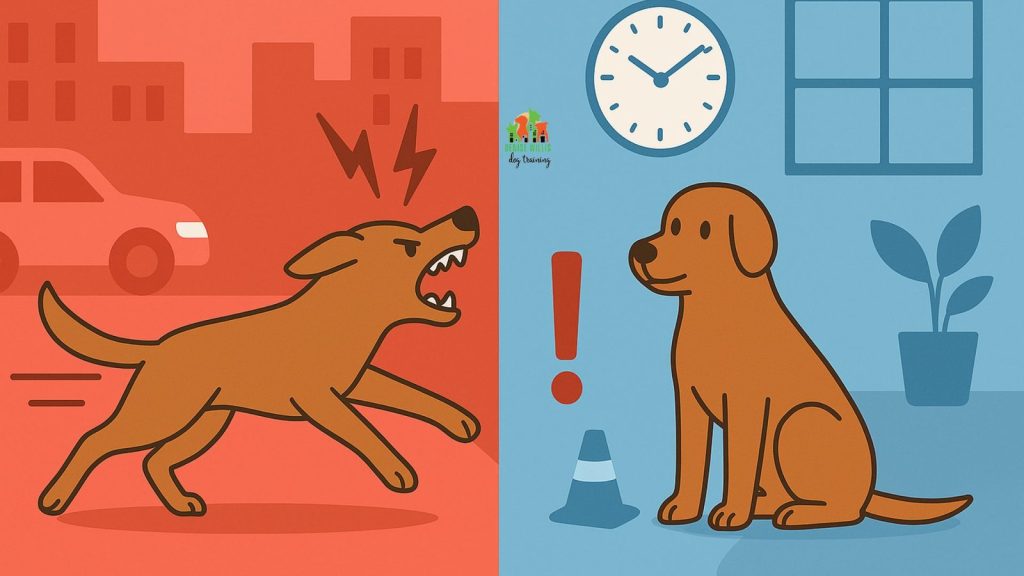The importance of positive leadership in correcting problematic behaviors in dogs

Dogs are remarkably intuitive creatures, often reflecting the behavior of their leaders. When faced with problematic behaviors, the role of a dog’s owner or trainer becomes crucial. Effective training is the foundation for a harmonious relationship between humans and their dogs. This connection is not merely about obedience; it’s about creating a lasting bond built on trust and mutual understanding.
- Positive reinforcement fosters trust and reliability. By rewarding desired behaviors with treats, praise, or play, owners can encourage their dogs to repeat these behaviors, reinforcing a positive cycle that also deepens their bond.
- Leadership encourages consistent communication between the dog and owner. Clear signals, both verbal and physical, create an atmosphere where dogs feel safe to express themselves. This consistency builds a framework for effective interaction.
- Solution-focused approaches lead to long-term behavioral changes. By focusing on what a dog can do rather than what it can’t, owners can find constructive paths to address issues, enhancing both the dog’s well-being and the owner’s enjoyment of their companionship.
Many dog owners struggle with issues such as aggression, excessive barking, or anxiety. These challenges are common, with American Kennel Club reports indicating that behavioral problems are one of the top reasons dogs are relinquished to shelters. Traditional methods may seem effective in the short term but often exacerbate the problem in the long run due to reliance on punishment or negative reinforcement. It’s essential to explore innovative strategies that prioritize positivity and understanding, steering away from outdated methodologies.
Why Choose Positive Leadership?
Positive leadership not only promotes a supportive environment for dogs but also enriches their social development. When owners practice positive reinforcement, they:
- Enhance the bond with their pets, which can lead to improved cooperation and willingness to learn.
- Encourage better learning outcomes by aligning training methods with the innate behaviors and motivations of dogs. For example, using toys or favorite activities as rewards can be far more effective than treats alone.
- Reduce stress for both dog and owner. Studies show that stress can negatively impact a dog’s ability to learn, making it crucial for owners to create a relaxed atmosphere.
By adopting a positive leadership style, dog owners can effectively address behavioral issues while nurturing a loving connection. This approach not only benefits the dog but also transforms the entire experience of pet ownership into a fulfilling journey. As we move forward in understanding canine behavior, it becomes ever clearer that a focus on positivity is the key to fostering not just well-behaved dogs, but also joyful partnerships between people and their furry companions. Exploring resources, such as workshops or training classes dedicated to positive reinforcement can further enhance this experience.
DISCOVER MORE: Click here for effective strategies

The Role of Positive Leadership in Dog Behavior Management
In the world of canine companionship, the relationship between dog and owner is often likened to a partnership grounded in mutual respect and trust. Effective leadership, particularly when rooted in positive reinforcement, serves as a catalyst for transforming problematic behaviors in dogs. Such behaviors—including aggression, destructive chewing, and separation anxiety—can pose significant challenges for owners and may even lead to a breakdown in the human-animal bond. However, understanding the importance of positive leadership can not only aid in correcting these behaviors but also enrich the overall experience of dog ownership.
One of the primary advantages of positive leadership is how it establishes a trusting relationship between dog and owner. When a dog is rewarded for exhibiting desirable behaviors—whether it’s through verbal praise, treats, or engaging activities—it fosters a sense of security and reliability. Over time, this relationship can lead to better cooperation, making the training process smoother and more effective. For instance, when a dog learns that sitting calmly results in a tasty snack, it becomes more likely to repeat that behavior in the future.
Furthermore, positive reinforcement not only encourages good behavior but also reduces the likelihood of unwanted actions. A study conducted by the American Veterinary Society of Animal Behavior highlighted that dogs trained through positive methods are less likely to exhibit fear and aggression compared to those subjected to aversive training techniques. A gentle nudge towards desired behavior is often more effective than punitive measures, which can lead to confusion and anxiety in dogs.
- Promotes Emotional Well-being: By creating a supportive atmosphere, owners can reduce stress levels for both themselves and their dogs, contributing to improved health and happiness for the pet.
- Facilitates Effective Communication: Through consistent use of commands and positive cues, owners can communicate clearly with their dogs, allowing them to understand expectations and respond appropriately.
- Encourages Lifelong Learning: A dog conditioned through positive reinforcement is more likely to remain engaged in learning throughout their life, continuously building skills and enhancing their adaptability.
Moreover, choosing a positive leadership approach can pave the way for long-term behavioral changes. Instead of dwelling on failures or setbacks, focusing on what a dog can achieve helps to cultivate a mindset of success. For example, rather than punishing a dog for barking excessively, an owner can redirect that energy into learning a new command, turning potential chaos into constructive engagement.
By understanding and implementing the principles of positive leadership, dog owners can navigate the complexities of canine behavior correction more effectively. By prioritizing trust, emotional well-being, and constructive interaction, owners not only enhance their dogs’ quality of life but also enrich their own experiences as responsible pet guardians. The journey toward correcting problematic behaviors is thus transformed into an opportunity for growth and deepening companionship—a true testament to the power of positive leadership in the realm of dog training.
| Advantage | Description |
|---|---|
| Enhanced Trust | Positive leadership fosters trust between the dog and the owner, allowing for better communication and understanding of behavioral issues. |
| Long-lasting Change | Utilizing a positive reinforcement approach enables more durable behavioral corrections, ensuring that dogs retain the training over time. |
Effective dog training requires more than just addressing unwanted behaviors; it involves cultivating a relationship built on respect and empathy. Positive leadership is critical in establishing a confident atmosphere where dogs feel safe to learn. This method contrasts sharply with traditional punitive measures, which can breed fear rather than compliance. The implementation of consistent positive reinforcement—like treats, praise, and play—can turn problematic behaviors into opportunities for growth.Understanding dog emotions is essential for effective leadership; managing stress in training sessions can lead to a more receptive dog. Consider your dog’s body language and responses; if they seem anxious or hesitant, it may be necessary to modify your approach. Positive leadership not only aids in correcting undesirable behaviors but also enhances the overall bond between you and your furry companion, leading to a healthier and happier life together. By investing time into this technique, dog owners can enjoy a fulfilling and harmonious relationship with their pet, making training a rewarding experience rather than a chore.
DISCOVER MORE: Click here to find helpful strategies
Building a Foundation of Understanding Through Positive Techniques
To effectively correct problematic behaviors in dogs, it’s essential to delve deeper into the principles of positive leadership and how they can be utilized to shape a dog’s behavior with empathy and understanding. Among the various strategies, implementing consistent routines can enhance a dog’s sense of security, enabling them to navigate their environment with confidence. Routine provides structure, which is especially beneficial for dogs that exhibit anxious behaviors, such as excessive barking or chewing on household items due to boredom or stress.
For example, integrating regular exercise into a dog’s daily schedule—such as walks or playtime—can alleviate pent-up energy that might otherwise manifest as unwanted behaviors. A well-exercised dog is less likely to engage in destructive activities stemming from frustration or anxiety. According to the American Kennel Club (AKC), breeds with high energy levels, like Border Collies and Labrador Retrievers, benefit significantly from physical and mental stimulation. This highlights the importance of adopting a holistic view of a dog’s requirements, which includes physical needs alongside behavioral training.
In addition to routines, positive socialization plays a pivotal role in correcting behavioral issues. Exposing dogs to diverse environments, people, and other animals from a young age helps them become well-adjusted adults. Positive experiences during social interactions promote a lasting impression that discourages aggressive or fearful behavior. For instance, taking a puppy to a well-mannered dog park, where they can engage with friendly canine peers, allows them to learn proper dog-to-dog social cues. This friendly exposure can significantly reduce the occurrence of aggressive tendencies later in life.
- Utilizing Training Classes: Enrolling dogs in positive reinforcement-based training classes not only hones their skills but also strengthens the bond between dog and owner through shared experiences and achievements.
- Implementing Clicker Training: This technique uses a sound to mark desirable behaviors, helping dogs understand what actions please their owners, all while maintaining a focused and positive atmosphere.
- Encouraging Problem-Solving: Engaging dogs in interactive toys and puzzles nurtures their cognitive skills and natural instincts, redirecting their attention away from unwanted behaviors towards productive activities.
Moreover, understanding the psychology of dogs can revolutionize how owners approach behavior correction. Dogs thrive on consistency; thus, maintaining a calm and assertive demeanor is vital when addressing undesirable actions. A study published in the journal “Applied Animal Behaviour Science” suggests that dogs trained with positive reinforcement techniques show increased levels of attentiveness and willingness to learn. This finding underscores the importance of acknowledging a dog’s perspective while effectively communicating expectations.
As owners embrace the principles of positive leadership, they can cultivate an environment where dogs feel safe to explore and learn from their surroundings. This atmosphere not only encourages dogs to correct their behaviors but also fosters a rewarding relationship built on trust. Each positive interaction, whether through training, playtime, or simple affection, reinforces the bond between owner and pet. This, in turn, creates a strong foundation for resolving behavioral issues and enhances the overall quality of life for both parties.
LEARN MORE: Click here for essential insights
Conclusion: The Transformative Power of Positive Leadership
In summary, the journey toward correcting problematic behaviors in dogs is a rewarding path that hinges on the principles of positive leadership. By fostering an atmosphere of trust, understanding, and patience, dog owners can create an environment conducive to learning and growth. The emphasis on consistent routines, positive socialization, and employing effective training techniques are not merely strategies; they are the cornerstones of a healthy relationship between dogs and their owners. Each of these elements contributes to a dog’s emotional well-being, enabling them to express their needs and emotions in constructive manners.
Moreover, the insights gleaned from understanding the psychology of dogs underscore the importance of patience and empathy in training efforts. Recognizing that dogs are not only responding to commands but also to emotions reshapes the landscape of behavioral correction. A calm and assertive approach can lead to significant improvements in a dog’s willingness to learn and adapt, breaking the cycle of negative behaviors and paving the way for positive change.
Ultimately, embracing positive leadership not only benefits the dogs but also enhances the overall experience of pet ownership. With each milestone achieved through positive reinforcement, owners witness a deepening bond with their dogs, filled with mutual respect and affection. As the understanding of canine behavior evolves, so too should our methods of teaching and correction. The ripple effects of positive leadership extend beyond individual dogs, influencing families and communities by promoting responsible pet ownership and fostering well-adjusted canine companions. Now is the time to dive deeper into these techniques, explore additional resources, and transform how we lead our furry friends toward a happier, healthier life.


